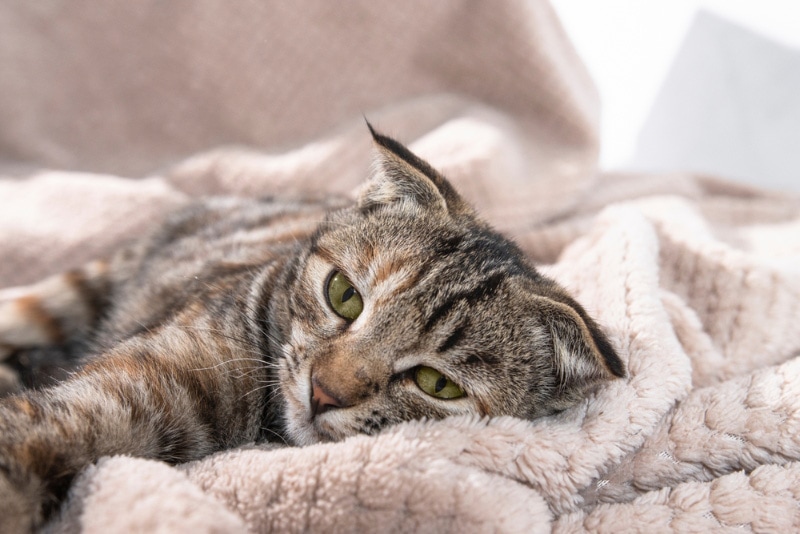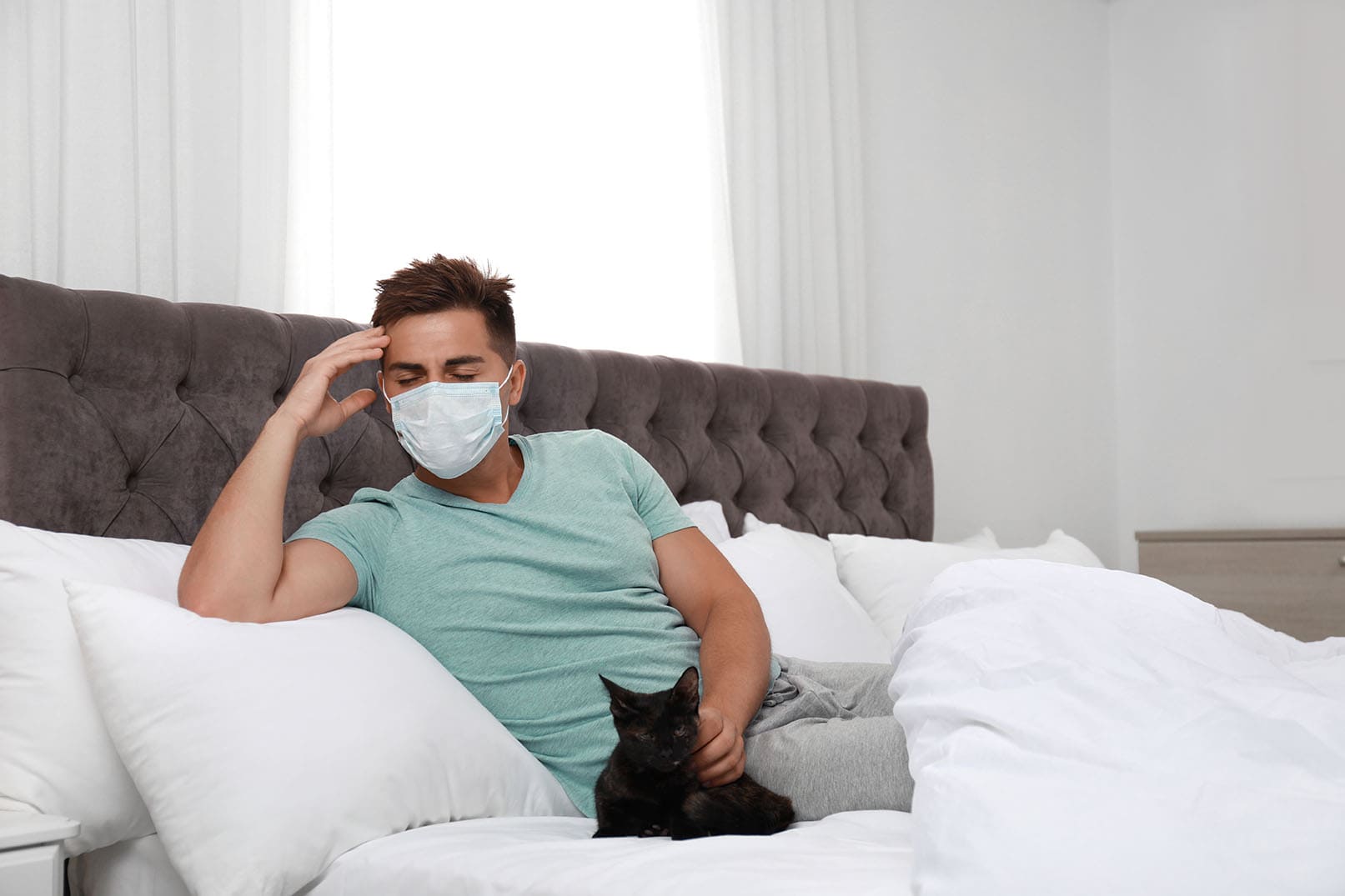- March 20, 2024
How Do I Know if I’m Allergic to Cats? 6 Signs to Look For (Vet Approved)



The information is current and up-to-date in accordance with the latest veterinarian research.
If you love cats but have a cat allergy, things can be tough, especially if you want to live with a cat. Some people aren’t sure if they are allergic to cats, so it helps to know what signs would indicate that you might be allergic to felines. Of course, any health problems should be addressed by a medical professional, so if you suspect that you might have an allergy to cats, it’s important that you follow up with your doctor.
If you’ve started spending time around a cat and you experience any of the signs below, it could very well mean you have a cat allergy.

The 6 Signs of Cat Allergies
1. Runny Nose or Sneezing
Some of the most common indicators of an allergy to cats is sneezing, stuffy nose, and runny nose. When you’re exposed to a cat, the allergens on the cat become airborne, whether it’s from the movement of the cat itself, or stirring up allergens in the environment. When these allergens become airborne, you breathe them in.
In allergy sufferers, the body reacts to the presence of the allergen in the nasal passages, creating an increase in mucus production and stimulating sneezing in an attempt to remove it.

2. Watery or Irritated Eyes
Watery, red, and irritated eyes are also common signs of an allergic reaction to a cat. These reactions occur in a similar way to nasal irritation. The eyes come into contact with an allergen and a cascade of automatic responses occur in the body, causing the eyes to water. Red, itchy, or watery eyes are all the body’s way of attempting to flush allergens out of the eyes.
3. Skin Rash
Histamine reactions to the presence of allergens can occur throughout the body, leading to a slew of allergy indicators. While skin rashes and irritation may not be as common as the previous allergy signs, they are very common for people with a cat allergy who come into physical contact with a cat.
Rashes are likely to worsen with longer contact with the cat, so it’s important for someone who suspects or knows they have a cat allergy to wash their skin where the cat contacted them, as well as put on clean clothes after handling a cat.

4. Facial Pain
This allergy sign may not sound like something that could happen simply by being exposed to a cat, but it actually makes perfect sense. Since exposure to the cat allergen causes multiple reactions within the sinuses of the face, like runny nose and sneezing, the sinuses may become irritated or inflamed. When this happens, it can lead to facial pain, especially just above the inner corners of the eyebrows and on both sides of the face beside the nose, which is where large sinuses reside.
5. Coughing or Wheezing
Coughing and wheezing occur for the same reasons as the nasal and eye reactions. Exposure to the allergen within the respiratory system creates a reaction within the body that causes coughing. However, wheezing can also occur when exposed to an allergen. This is because the histamine released by the body to fight the allergen also causes the airways to become irritated and inflamed, causing them to become smaller.
On top of that, there is an increase in mucus production as the body attempts to “trap” and expel the allergen. This increase in mucus within constricted airways can lead to wheezing, which can occur on a spectrum from mild to severe.

6. Anaphylaxis
Anaphylaxis is a medical emergency that can lead to death very quickly if left untreated. This is an indicator of a very severe allergy, and for people with an allergy this severe, the risk of being around a cat is far too dangerous for them.
Anaphylaxis causes the airways to completely constrict, causing the person to begin suffocating. While there is a component of anaphylaxis that is caused by reactions within the respiratory system, it’s actually a multi-organ reaction that is mediated by a variety of factors and responses within the body. No matter the cause, anaphylaxis is always considered an emergency.
Fortunately, this type of reaction to cats is extremely rare.

What Causes Cat Allergies?
There is a common misconception that people with allergies to cats are allergic to their hair, but this isn’t actually the case. Allergies are a response to proteins, so what people are actually allergic to is the cat’s dander (dead skin cells), as well as their saliva and urine.
When the human body is exposed to an allergen, a histamine reaction occurs. This means that the body’s immune system kicks into overdrive and begins desperately trying to flush the allergen from its system. Allergies, as we know them today, don’t serve an essential function of any kind for people; they are simply the body overreacting to the presence of an allergen.
It is also worth noting that different cats can produce different protein profiles. That means that some people will be allergic to some cats, but not all of them. If you’re thinking of adding a cat to the family, it is worth spending time with them to see if they trigger any allergy signs first.

Can Cat Allergies Be Treated?
In some people, the more they are exposed to an allergen, the less severe the reaction becomes. For others, the opposite is true. If you have your heart set on a cat, talk to your doctor about allergy testing and the best ways to alleviate your signs. There are plenty of options available, from antihistamines to immunotherapy.
Apart from treating the allergies themselves, there are a number of ways to reduce the allergen load around your home:
- Keep cats out of your bedroom
- Vacuum, vacuum, vacuum
- Regular grooming – preferably have a friend or family member do this task, or even book a regular appointment with a groomer. Although the allergy isn’t to their coat, less fur flying around will equal fewer airborne allergens
- Use air purifiers with HEPA filters

Conclusion
Dealing with having an allergy to cats can be a real bummer, but it’s extremely important to address your potential allergy instead of ignoring it. If you have any of these signs of an allergy to cats, make sure to talk to your doctor about management and treatment options. Although severe allergies will often mean that you cannot share your home with a feline friend, there are lots of ways to reduce allergens in the home, as well as options to relieve your allergy symptoms.
Featured Image Credit: Ground Picture, Shutterstock
Tags
What do you think?
Related Articles

New Puppy Checklist: Gear You’ll Need for Your New Dog
Getting a new puppy is really exciting, but before you welcome them home, it’s important to prepare your space for them. Since puppies need a

How Big Do Mini Poodles Get? Vet Reviewed Average Weight & Growth Chart – Dogster
The information is current and up-to-date in accordance with the latest veterinarian research. Learn more » When you buy a Miniature Poodle, you might not

Can Police Dogs Smell Nicotine? Vet Verified Facts & Info – Dogster
The information is current and up-to-date in accordance with the latest veterinarian research. Learn more » While cigarette sales have been declining steadily for decades,

How Old Is 5 in Dog Years? Vet-Approved Guide to Each Size of Dog – Dogster
The information is current and up-to-date in accordance with the latest veterinarian research. Learn more » A common method for calculating a dog’s age is

